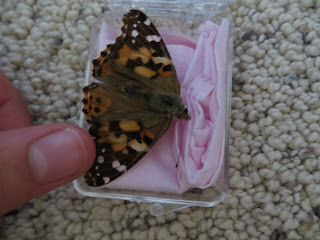Monday, August 26, 2013
Cellular respiration
ATP
Mating Behavior
meristem
Stigma & style of carpel
r-strategist
Fermentation
Sunday, August 25, 2013
exoskeleton
tropism
niche
mutualism
Krebs cycle
cambium
batesian mimicry
heterotroph
Sunday, August 18, 2013
Frond
commensalism
bilateral symmetry
Eukaryote
Seed Dispersal (Animal)
Basidiomycete
 |
| This mushroom found in the woods by my house is a basidiomycete, meaning it is a member of a large group of fungi bearing sexually produced spores on a basidium. Basidia can not be seen with the naked eye. They cover the gills of the mushroom, and the interior surfaces of the tubes in mushrooms with pores. Each basidia holds two or four spores each. |
Flower Ovary
 |
| The bulb seen at the bottom of this squash flower growing in my garden is called the ovary. An ovary is part of the female reproductive organ of the flower. This ovary will actually grow into a baby squash. Since the petals and sepals are above the ovary, the squash is said to have an inferior ovary; as opposed to a superior ovary which is located above. |
Monday, August 12, 2013
Gymnosperm Leaf
Gymnosperm cone
 |
| A gymnosperm cone is the gametophyte of the plant. The male cones are further up the tree and smaller, while female cones are larger and further down the tree. Female cones generate seeds and male cones produce pollen. Since the male cones are further up than the female, when their pollen is released it will fall down and stick to the female cones. Once fertilized, the zygote grows into an embryo that is encased in a seed. The female cone then released the seed. This gymnosperm cone found on a tree in my backyard is a female cone because it is near the bottom of the tree. |
Calvin Cycle
 |
| The calvin cycle is a metabolic pathway found in the stroma of the chloroplast in which carbon enters in the form of CO2 and leaves in the form of sugar. It is also known as the C3 cycle. The calvin cycle is the second stage of photosynthesis that doesn't require light to occur. This plant goes through the process of photosynthesis, and therefore also goes through the calvin cycle. |
Pollen
 |
| Pollen is the microspores of seed plants that is shed from anthers. Pollen contains microgametophytes, which produce the male gametes (sperm cells). Pollen grains have a hard coat that protects the sperm cells as them move from the stamens to the pistil of a flowering plant. When the pollen lands on a pistil, it germinates and produces a pollen tube that transfers the sperm to the ovule. It is shown here as the powdery yellow stuff. |
Cuticle Layer of a Plant
Auxin Producing Area of a Plant
Autotroph
 |
| Most plants on land or water are autotrophs, which are the producers in a food chain who provide the consumers with energy. Autotrophs are self feeding organisms who produce organic compounds (carbohydrates, fats, and proteins) using their surroundings, most commonly by means of light. This process is called photosynthesis. This picture shows a plant that is a common autotroph who uses the process of photosynthesis to convert organic compounds for energy use. |
Anther and Filament of Stamen
 |
| This picture is showing the anther and filament of a stamen, where pollen is produced and carried until a pollinator comes by and takes some of the pollen to another flower. The stamen is the stem that holds up the anther high so there is a greater chance for it to be pollinated. The anther is the little bulb at the top that holds all the pollen. The pollen is the yellow powdery stuff. |
Sunday, August 4, 2013
Ectotherm
 |
| Ectotherms are dependent on external sources of body heat. This dead monarch butterfly (don't worry, it was found dead) is ectothermic because it depends on the sun's heat to warm it up. They usually try to warm up before they fly, orienting their wings towards the sun. |
Asexual Reproduction
 |
| Asexual reproduction is any reproductive process that doesn't involve meiosis or syngamy. Because a asexual organism lacks new genetic material, it clones itself and makes genetically identical organisms. Asexual can be an advantage, or disadvantage. One advantage is that it can create individuals quickly and in large quantities. However, if something goes wrong, like a fatal mutation, the whole society of clones can be destroyed. These raspberries reproduce through asexual reproductions. They are all clones. |
Animal With Segmented Body
 |
| Segmentation is the subdivision of the body into recurring segments. The ant pictured above has a segmented body. It's body is divided into 3 parts: the head, thorax, and abdomen. |
Analagous Structures
 |
| My eye is an example of an analagous structure because the human eye is very similar to the eye of an octopus, other than the fact that we have a blind spot and they don't. However, the octopus and human eye are not closely related and are on two different branches of the tree of life. This means that they are analagous structures because the eyes function the same in both species but they evolved independently of another and are not descended from a common ancestor. |
Subscribe to:
Comments (Atom)























